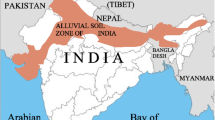Abstract
The performance of pavement depends on the strength of sub-grade soil. In order to execute an effective and reliable pavement design, an accurate and representative material characterization technique is essential. Such a technique would be even more beneficial if it were simple and could be applied rapidly. In situ California bearing ratio (CBR) value is one of the traditional methods for the strength characterization of the sub-grade soil. The dynamic cone penetrometer (DCP) is an instrument, which can be used for rapid evaluation of the strength of soil in field condition. DCP has been intended to improve on many of the deficiencies of systems that are manually pushed into soil or proving materials. The instrument is relatively simple in design and operation, and operator variability is reduced and thus correlations with soil parameters are more accurate. In the present study, an empirical correlation has been developed between DCP penetration rate and CBR value with different soils collected from different roads. Statistical compatibility analysis has been done for comparison with different models available in literature.


Similar content being viewed by others

Data Availability
There is no availability of data and material.
Code availability
There is no code availability.
References
ASTM D6951–09 “Standard test method for use of the dynamic cone penetrometer in shallow pavement applications,” ASTM International, West Conshohocken, PA19428–2959, United States (2009).
Coonse J (1999) “Estimating California bearing ratio of cohesive piedmont residual soil using the scala dynamic cone penetrometer,” Master’s thesis (MSCE), North Carolina State University, Raleigh, N.C
Gabr MA, Hopkins K, Coonse J, Hearne T (2000) DCP criteria for performance evaluation of pavement layers. J Perf Const Fac 14(4):141–148
George V, Rao NC, Shivashankari R (2009) PFWD, DCP and CDR correlations for evaluation of lateritic subgrades. Int J PavEng 10(3):189–199
Harison IR (1987) Correlation between California bearing ratio and dynamic cone penetrometer strength measurement of soils. Proc Instn Civ Engrs London 2(83):833–844
IS2720–31, “Method of test for soils - part 31 field determination of California bearing ratio,” Bureau of Indian Standards, New Delhi, INDIA (1990).
Kleyn EG (1975) “The use of the dynamic cone penetrometer (DCP),” Rep. No. 2/74, Transvaal Roads Department, South Africa
Lin L, Li S, Liu XL, Chen WW (2019) Prediction of relative density of carbonate soil by way of a dynamic cone penetration test. Géotech Lett 9(2):154–160
Livneh M (1987) “The use of dynamic cone penetrometer in determining the strength of existing pavements and subgrade,” Proc 9th Southeast Asia Geotech Conf, Bangkok, Thailand
Livneh M, Ishai I, Livneh NA (1992), “Effect of vertical confinement on dynamic cone penetrometer strength values in pavement and subgrade evaluations,” Transp Res Rec, 1473 Transportation Research Board, Washington, D.C.
Mohammad LN, Ananda H, Abu-Farsakh MY, Gaspard K, Gudishala R (2007) Prediction of resilient modulus of cohesive subgrade soils from dynamic cone penetrometer test parameters. J Mat Civil Eng 19(11):986–992
Sahoo PK, Reddy KS (2009) Evaluation of subgrade soils using dynamic cone penetrometer. Int J Earth Sci and Eng 2(4):384–388
Transport Research Laboratory (1993) “A guide to the structural design of bitumen-surfaced roads in tropical and sub-tropical countries,” Overseas Road Note 31, Crowthorne, Barkshir, United Kingdom (1993).
Webster SL, Grau RH, Williams TP (1992) “Description and application of dual mass dynamic cone penetration”, Instruction Report GL-92-3. Department of Army, Washington DC
Author information
Authors and Affiliations
Corresponding author
Ethics declarations
Conflict of interest
The author declares no competing interests.
Additional information
Responsible Editor: Mohamed El-Ghali.
Highlights
• A correlation between California bearing ratio (CBR) and dynamic cone penetrometer (DCP) penetration rate is developed.
• Three different types of soil have been taken in consideration to help accomplish a generalized correlation.
• The correlation is compared with relations available in literature.
This article is part of the Topical Collection on Diagenesis and Reservoir Quality within Sequence Stratigraphy.
Rights and permissions
About this article
Cite this article
Meshram, K. Estimation of field CBR from DCP for subgrade soils. Arab J Geosci 15, 898 (2022). https://doi.org/10.1007/s12517-022-10048-y
Received:
Accepted:
Published:
DOI: https://doi.org/10.1007/s12517-022-10048-y



